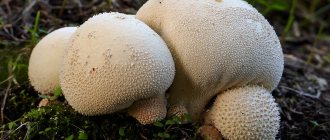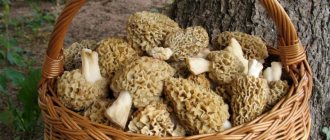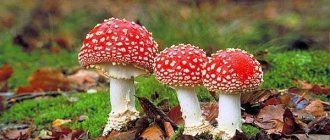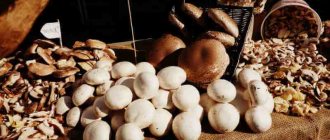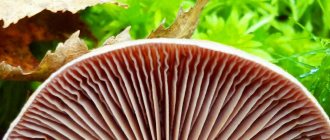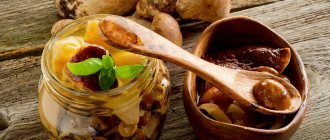White float (pusher) is an edible mushroom of food category 4. This mushroom definitely belongs to the risk group. Being a close relative of the notorious stinking fly agaric, toadstool and other extremely poisonous mushrooms, it has a certain similarity with them. And it would be good if it had some outstanding taste qualities.
But no, this mushroom is rather tasteless, and it does not tolerate transportation well, its cap crumbles very much. Based on the above, I would not recommend picking these mushrooms, especially if you are a mushroom picker without much experience. The risk is very high and the benefit is doubtful.
Mushrooms Pushers (Floats): description, photo
Floaters (pusher mushrooms) are a species considered theoretically edible. It does not have high nutritional value and belongs to the fly agaric genus. This is an unattractive individual both in appearance and in taste.
Mushroom pushers
Appearance
The pusher (Amanitopsis alba), according to the description, has a leg 0.8-1.2 cm in diameter, its height is 5-15 cm. The color is white or gray. Saffron float mushrooms (Amanita crocea) differ from gray ones (Amanita vaginata) in the color of their cap.
The surface of the mushroom float has a variety of colors: gray, yellow, orange. The cap of an adult individual reaches 4-9 cm in diameter. In juveniles it is bell-shaped, in adults it is already flat, and occasionally flat-convex.
The float plates are white, loose and dense. The spore powder is also white. The spores are spherical, non-amyloid, the surface is smooth.
The float mushroom is similar to the fly agaric even in its chemical composition, but some scientists refuse to consider them related species.
The height of the mushroom stem is 5-15 cm, the diameter of the cap is 4-9 cm
Kinds
The gray float mushroom is an edible species. It is noticeable due to the gray color of the fragile cap, 4-8 cm in diameter. Its central part is a darker shade. It has an ovoid-bell-shaped shape, sometimes flat.
The edge is ribbed all the way around. Leg height 5-12 cm. Colors - white, beige, gray. The plates are white and loose. These mushrooms grow in late summer and early autumn, singly or in large numbers at a short distance.
There is a possibility of encountering the following species:
- Yellow-brown pusher mushroom. It has an unusually colored cap. The edges are white, towards the center they change from brown, orange shades to dark, almost black in the central part.
- Saffron is distinguished by a saffron and orange cap, which has a dark color in the central part. This shade is also on the legs. The plates are often yellow. They grow rarely, preferentially in swampy areas (singly and in groups).
- Umber-yellow pusher mushrooms (also called Battarra's fly agarics) have a dark color in the central part of the cap, while their edges are yellow or brown. The leg also has this shade. There are small scales on it.
- The white float is a mushroom that has a stalk with pale scales, on which there is an ovoid or flat-shaped cap with a small bump in the central part. Its size reaches 10 cm in diameter. The flesh is white, but fragile and crumbles quickly. This species grows in mixed and deciduous forests, near birches.
- Snow-white pushers, according to the description, are the smallest species. Its leg is 7-10 cm high, and its cap is 3-7 cm in diameter. Young individuals have flakes. Over time, they disappear, and the shade of the leg also changes: white becomes gray.
Beneficial features
Pushers are nutritious. They have special biologically active components called betaines. Betaines are beneficial for humans because they affect the metabolic process in the body. The composition is similar to that characteristic of float and porcini mushroom.
Pusher contains many vitamins, especially group B, and other microelements, as do other edible types of fly agaric.
Pushers are nutritious and healthy
Contraindications
This species does not pose a threat to human life and health. According to the description, it looks similar to a toadstool, so there is a risk of confusing these mushrooms. In this case, intoxication of the body will occur. It is also possible to get poisoned from the float if it was collected near industrial areas or roads: it quickly absorbs bad substances from the environment.
You should not eat mushrooms if you have a number of diseases:
- diabetes;
- poor kidney and liver function;
- hypertension.
The variety is excluded from the diet if there are allergic reactions to this particular species.
Application
The float is unattractive in appearance, tastes fresh, with bitterness, so it is not particularly popular among mushroom pickers. Collecting, transporting, processing and cooking with this species is not easy: the structure of the mushroom is fragile and brittle. At the same time, it is extremely popular in dietary nutrition.
In cooking
The float is used in cooking after cooking. it's great for drying. amanitopsis is used for preparing first and second courses and appetizers.
The process of preparing pushers is no different from other types of cooking. To begin with, they are delicately cleaned of dirt and washed with plenty of water. the next step is to cook for about an hour. It is possible to salt or marinate amanitopsis without resorting to soaking or scalding in advance.
in medicine
This species of the fly agaric genus contains a lot of betaine. in medicine, this chemical compound is used to combat Alzheimer's disease, breast cancer, prostate adenoma, liver, kidney and gall bladder diseases.
mushroom hunting. saffron float and boletus. float - an edible summer mushroom (amanita fulva) a relative of the fly agaric - yellow-brown float.
conclusion
Pushers, or floats, are fragile and brittle mushrooms that require delicate handling.
Source: //FermoVed.ru/gribyi/tolkachiki-poplavki.html
Beneficial features
Floats are suitable for dietary nutrition
Pushers are classified as dietary mushrooms - only 24 kcal per 100 g.
The pulp contains a whole range of components useful for the body:
- all B vitamins, as well as C, E, PP;
- beta-carotene;
- ash substances;
- alimentary fiber;
- amino acids (eg cysteine, leucine, threonine, valine);
- microelements - magnesium, iron, phosphorus, calcium, zinc, manganese, sodium, potassium.
Thanks to such a balanced and healthy complex, the forest product is of great value to our body - it saturates it with vitamins and minerals, which helps increase immunity, improve general condition and mood.
Float mushroom – edible
The float is white and belongs to the fly agaric family. Mushroom pickers don't like him because of his appearance. It resembles a stinking fly agaric, or a pale toadstool.
You can distinguish it, but you need to be extremely careful. The first sign of a white float is that it really is white. The cap may be slightly darker than the spore-bearing plates. It reaches fifteen centimeters in diameter, and in its center the remains of the blanket that protects the fungus during growth are clearly visible.
The edge is uneven and ribbed. This mushroom has no particular odor. When cut, the pulp does not change color.
You can find this mushroom in deciduous forests. The difference between this mushroom is the ribbed edges of the cap, a pouch at the base and the absence of a ring on a thin, high stem. These mushrooms can only be collected from July to the end of September.
These mushrooms can be used in cold appetizers, as well as stewed and fried, but they must first be boiled.
The float is white. White pusher (Amanitopsis alba)
The float is white. White pusher (Amanitopsis alba) photo
It is found in autumn in birch and coniferous forests with an admixture of birch, very rarely and not abundantly. The entire mushroom is snow-white. Otherwise the same as the gray float. Edible, fourth category, pleasant to the taste.
Used boiled. The white pusher can be confused with the deadly poisonous stinking fly agaric (see comparative table).
Yellow-brown floater (Amanita fulva)
Yellow-brown floater (Amanita fulva) photo
Grows in birch forests, along the outskirts of swamps from July to September. The hat is yellow-brown. Otherwise the same as the gray float.
Floats differ from fly agarics in the absence of a ring on the stem. Edible mushroom , belongs to the fourth category. Used boiled.
The float is gray. Gray pusher (Amanita vaginata)
The float is gray. Gray pusher (Amanita vaginata) photo
It usually grows in single specimens in a wide variety of forests and shrubs from July to the end of August.
The cap is up to 10 cm in diameter, gray, bell-shaped in young mushrooms, almost flat in mature ones, with a tubercle in the center and a ribbed (ribbed) edge. The skin of the cap is dry, with white flakes in young ones, which later disappear.
The flesh of the mushroom is thin and white. Spore powder is white.
The leg is up to 15 cm long, 1-2 cm thick, white, fluffy-scaly or smooth, expanded at the base and placed in a wide, bag-like volva (white, gray or brownish), which is deeply buried in the ground. There is no ring on the leg. The gray float is edible , category four.
Used boiled.
Saffron float (Amanita crocea)
Saffron float (Amanita crocea) photo
Found in deciduous and mixed forests from July to October. The cap is up to 7 cm in diameter, orange-ochre. The edge is ribbed and striped. The plates are white.
Spore powder is white. The leg is up to 12 cm long, 0.5-1 cm thick, white, fibrous-scaly, with ocher-twisting belts. Volva is white, loose. Saffron float is edible , category four.
Used boiled.
Saffron float
- What do mushroom floats
?
Where and when do they grow? Photo of floats
. And a lot of other useful information about these mushrooms. - Mushroom float
.
All types of floats
with photos and descriptions of their differences.
... Headings: P, Conditionally edible mushrooms
.
float
(Amanita alba) Hat: ... - May 29, 2010 ... float
- this
mushroom
from the fly agaric family is frankly not liked by mushroom pickers of all stripes. They don’t like him for his provocative... - Fly agarics and edible float
.
Among fly agarics there are several types of edible ones
, but they are of low quality. Such, for example, are fly agaric... - The float
is gray. Gray pusher (Amanita vaginata). Photo, description, growth, category and use, where it grows. Tasty and nutritious... - The float
is white. White pusher (Amanitopsis alba). Photo, description, growth, category and use, where it grows. Tasty and nutritious...
Gray
float a mushroom
from the genus Fly Agaric of the Amanitaceae family.
…. Conditionally edible mushroom
of good quality.- Sometimes the floater
is confused with the pale grebe (Amanita phalloides).
But these mushrooms
have significant differences:
the float
does not have a ring on the stem, ...
Source: //gribochik.ru/sedobnye-griby/1965-grib-poplavok-sedobnyj.html
Use in cooking
This product is in great demand among chefs - it can be canned, fried, boiled, stewed and pickled. You can take note of several interesting recipes.
Recipe 1. Soup
- young fruiting bodies - 350 g;
- potatoes - 3 pcs.;
- smoked ribs - 200 g;
- onion - 1 pc.;
- carrot - 1 pc.;
- canned green peas - 100 g;
- tofu cheese - 50 g;
- dill;
- salt pepper.
Read also: Wedding bouquet of white orchids
Soak the mushrooms in cold water for an hour. Peel the onion and chop it. Grate the carrots on a fine grater. First fry the onion in vegetable oil until golden brown, then add the carrots.
Boil the ribs. Peel and cut the potatoes into cubes.
Mix all the ingredients together with the frying in one saucepan, pour in a couple of liters of water, salt and pepper to taste. Place over medium heat and cook until the potatoes are fully cooked.
Add peas, grated cheese, and chopped dill. Cook for another 5 minutes, remove from heat, leave for 20 minutes. Serve with sour cream.
Recipe 2. Floats in cream
Mushrooms are versatile in cooking
A couple of hours before preparing the dish, the mushrooms are soaked in warm water. Then they are thrown into a colander, cut into pieces, and fried in vegetable oil until golden brown.
Sprinkle with grated cheese (70-80 g), salt and pepper to taste, pour over lemon juice (½ tsp) and white wine (1 tbsp). cover with a lid and simmer over low heat for 25 minutes.
Recipe 3. Marinated mushrooms
For winter preparation you will need:
- floats - 1 kg;
- salad onions - 3 pcs.;
- bell pepper, carrots - 2 pcs.;
- a small piece of horseradish root.
Soak the mushrooms in warm water for 1.5 hours, then drain in a colander, transfer to a saucepan with clean water, cook for 20 minutes, drain the water.
Peeled onions are cut into rings, carrots and sweet peppers into strips. Peel the horseradish root and cut it into thin strips. Place all chopped ingredients in sterile jars. Boiled mushrooms are placed on top up to the neck.
The last stage is pouring the marinade. To prepare it you will need for 0.5 liters of water:
- salt - 2 tsp;
- sugar - a couple of pinches;
- black currant leaves - 5 pcs.;
- bay leaf - 2-3 leaves;
- black pepper - 5 peas.
Pour water into the pan according to the proportions, add all the ingredients, bring to a boil, and boil for 1-2 minutes.
Boiling marinade is poured over the mushrooms up to the neck, rolled up, and after cooling they are taken out for storage in a cellar or basement. You can try the preparation after 3 weeks.
Irina Selyutina (Biologist):
When preparing pushers (floats), you need to consider that:
- Collected mushrooms cannot be stored for a long time: they need immediate processing.
- Before cooking, all contaminants must be carefully removed from the fruiting bodies and washed thoroughly.
- It is recommended to boil the mushrooms for 40-50 minutes.
- You can salt and marinate without prior scalding or soaking.
If you want to be sure of the quality of mushrooms used for food, then remember that it is best to collect pushers, like other forest gifts, in areas with a favorable environmental situation.
Mushroom pushers
Pushers - or “floats”, as they are called in Russia - include the following types:
- white pusher.
- float saffron (or saffron).
- float gray.
- webbed float.
- lead-gray pusher.
- olive green pusher.
- large volvo float.
- the pusher is yellow-brown.
- the pusher is umber yellow.
All these names are “telling”: they reflect one or another feature by which one can not only distinguish the pushers from each other, but also distinguish them, say, from the gray (porphyry) fly agaric, false pusher or pale toadstool. This is all the more necessary since many cases of poisoning are attributed to pushers, which in fact were caused by completely different mushrooms, similar to them.
The peculiarity of the pushers is the presence of a bell-shaped, very fragile cap, which makes them very difficult to assemble and no less difficult to transport. As the mushroom matures, it also changes its shape, becoming flat-convex or completely flat.
Its obligatory element is a ribbed edge with clearly defined scars, sometimes there may also be a wide tubercle on it. The diameter of the cap is usually 4-12 cm.
As for its color, it can be very different - white, ash-gray, yellow-gray, orange-ochre, like a saffron float, lead-gray with bluish, white and olive-green tints - and this difference is often reflected in the species name of the mushroom.
The thin high leg of the pusher is hollow inside and no less fragile than the cap, ranging from 5 to 15 cm in height and up to 2 cm in thickness, and its lower part always has a bag-like volvo of gray, brown or white shades, which is often deeply immersed in the ground.
Pushers are also characterized by:
- light, elastic, fairly wide and frequently spaced plates.
- dryish skin of the cap with white flakes (a sign of a young mushroom), which subsequently disappear.
- thin, tender, slightly sweet-tasting, white pulp without a distinct odor.
- white spore powder.
- non-amyloid spores are round, often spherical, with a smooth surface.
- fluffy scales on the leg.
- ocher-twisting bands around the saffron float.
The easiest way to tell the pushers apart is by looking at the Volvo.
The gray float - the best known and most commonly collected - is grey, saffron, umber yellow, large volvo and fawn have red-brown spots on it.
The white pusher is so named because of the corresponding color, against which the center of its cap, painted grayish or brown, stands out. Various species also have orange, yellow-gray and gray-brown shades.
How to distinguish a pusher from a fly agaric or toadstool
It is quite difficult to recognize immediately where the pusher grows and where its inedible and poisonous counterparts are, so it is not surprising that such a bad and dubious reputation is gradually being assigned to it.
When it comes to distinguishing these mushrooms, even an experienced, sophisticated mushroom picker can make a mistake, not to mention beginners.
And although mushroom experts advise collecting pushers only to mushroom pickers who have considerable “experience” in this field, it seems to us that advice on how to distinguish them from fly agarics or toadstools will also be useful to those who are just starting to get involved in “quiet hunting”. Moreover, this requires only attentiveness.
The poisonous counterparts of the pusher are characterized by:
- leg ring. Edible float of any variety does not have it.
- presence of flakes on the cap and tuber.
- lack of a wide rounded plane.
- strength of the cap and stem.
- the presence of warty belts on the fruiting body.
The time of collection of floats also plays a big role - exclusively from July to the end of September. This seems all the more important because they grow on acidic and neutral soils in the same places where fly agarics and toadstools grow, preferring coniferous, mixed and deciduous - especially birch, oak and beech - forests.
What pusher mushrooms look like
Amanitorsis or “floats” have relatively small fruiting bodies and a semi-ovoid, wide conical or flat cap, the edges of which are very thin and grooved.
The cap is relatively thin and fleshy, sometimes with a fairly pronounced tubercle in the central part.
The color of the skin is most often pure white, whitish or grayish, but some specimens are characterized by a cap that is brown, brownish, reddish or orange in color.
The surface of the cap is shiny and smooth, dry or slimy. The thin and fairly brittle white pulp, as a rule, does not change color when cut. The spores are white.
Mushroom with a brown cap Astragalus membranaceus The most mushroom places in Volgograd, Tula, Samara and other regions of Russia
False honey mushrooms: description of appearance and place of growth
The “float” leg is cylindrical, most often hollow, fragile, with a smooth or patterned surface. Many specimens have a very characteristic and noticeable flaky coating. The lower part of the leg is widened, but without swelling. For different species, a white or grayish color is common, as well as a color identical to the cap.
Types of pusher mushrooms
Different types of "floaters" grow in forest areas of any type. The species collected by mushroom pickers belong to the category of conditionally edible, have a fairly good taste, but are not particularly popular, due to the increased fragility of the cap and dangerous resemblance to fly agarics.
How to avoid getting into trouble during a quiet hunt: useful tips for novice mushroom pickers
The float is strange
A. seciliae - has a bell-shaped or semicircular, and then a convex-spread cap of brown or reddish-brown color with relatively thick and fleshy flesh. The leg is cylindrical, with a slight expansion at the very base, as a rule, hollow, grayish in color, covered with grayish scales. Conditionally edible species.
Source: //ogorod.life/griby/griby-tolkachiki.html
Description of the appearance and taste of pusher mushrooms
Pusher mushrooms or “floats” from the fly agaric family are not very popular in our country and belong to the category of conditionally edible mushrooms with low nutritional value.
Pushers belong to the category of conditionally edible mushrooms with low nutritional value.
Float yellow-brown
A.fulva - has a smooth, slightly slimy, golden-brown or orange-brown cap of a bell-shaped or convex shape, with watery and whitish flesh. The leg is hollow and fragile, narrowed in the upper part, with a uniform whitish or whitish-brownish and slightly scaly surface. Conditionally edible species.
Saffron float
A.crocea - has a bell-shaped, convex or flat cap with fairly fleshy flesh and a rounded central tubercle.
The cap is covered with a smooth, shiny, slightly slimy surface of a bright orange or orangish-brown color.
The leg is straight, tapering or cylindrical, with brittle flesh, covered with thin orange scales. Conditionally edible species.
Saffron float
Snow-white float
A. nivalis - has a bell-shaped, convex or convex-spread white cap with a noticeable central tubercle and ribbed edges. The pulp is also characteristically white. The leg is cylindrical, widening at the base, white or grayish in color. Conditionally edible species.
Membranous float
A.submembranacea - has a broadly bell-shaped, convex or prostrate cap in the middle part with thick fleshiness and a slight elevation, characterized by the presence of pronounced ribbed edges.
The cap is covered with grayish-brownish or dark brown skin, which has an olive-greenish tint. The pulp is whitish, without any special taste or distinct odor.
The leg has a characteristic cylindrical shape, hollow, with a widening at the base, whitish or grayish in color, covered with a scaly or flocculent coating.
Description of the nutritional value and taste of pushers
Pusher mushrooms belong to the fourth category of mushrooms. Such mushrooms are rarely used for food purposes, and they are collected only by amateurs. Pusher mushrooms of all types are quite edible, but have no nutritional value, which is due to their hard consistency and chemical composition.
Places and times for collecting pushers
Almost all species are widespread in mountain and lowland coniferous and deciduous, as well as mixed forests. Some varieties even grow in Western Europe and northern Africa. The mushroom picking season varies depending on soil and climate conditions, but most often occurs in summer and early autumn.
It is imperative to collect pusher mushrooms of different types away from contaminated areas such as highways, industrial facilities, landfills and sources of toxic emissions. Due to the great fragility of the fruiting bodies, boxes or wicker baskets should be used for collection.
Poisonous and inedible doubles of pushers
There are a number of toxic and simply inedible look-alike mushrooms that can be mistaken for pushers by an inexperienced mushroom picker.
Porphyry fly agaric
A.porahyria has a bell-shaped or prostrate cap with grey, brownish-gray or greyish-purple skin covered with silky fibres. The pulp is thin, white, with a persistent smell of raw potatoes and a rare taste. The leg is smooth, white or light yellow, cylindrical in shape with a hemispherical thickening in the lower part.
Porphyry fly agaric
Amanita toadstool
A.citrina has a thick and fleshy, hemispherical, convex or almost flat, sometimes slightly depressed cap shape with thin, smooth and short-ribbed edges.
The cap is covered with grayish-yellow or slightly greenish, rarely off-white skin with large and whitish flakes. The pulp is white, soft, with a faint smell of raw potatoes and a very unpleasant taste.
The stem is tuberous or cylindrical, slightly expanded, whitish-yellow in color.
Also read: Umbrella mushroom: edible and poisonous species
Death cap
A. halloides has an olive, greenish or grayish cap that is hemispherical or flat in shape, with smooth edges and a slightly fibrous surface. The pulp is white, fleshy, with weak taste and a subtle mushroom aroma. The leg is cylindrical, with a thickening at the very base, whitish, covered with a very characteristic moire pattern.
Death cap
Fly agaric tall
A. excelsa has a hemispherical, convex or almost flat cap, which is distinguished by the presence of fibrous, but without pronounced ribbing, edges. The entire surface of the cap is characterized by sliminess or silky fibrousness.
The color of the cap is grayish or brownish, with a darker central part. The leg is cylindrical, with a pronounced bulbous shape in the lower part. Often the inside of the stem is hollow.
The surface is white or light gray in color, with the presence of flaky granular scales.
How to deliciously cook mushroom pushers
All types can not only be used in cooking immediately after collection, but also salted, pickled, and even dried . It is important to remember that collected mushrooms cannot be stored for a long time.
Fruiting bodies are subject to immediate sorting and processing. Mushroom soup is especially popular.
The fruiting bodies are first washed in water, all forest debris is removed and the dirt is carefully cleaned.
The most poisonous mushrooms (video)
Clean mushrooms are filled with water and boiled for forty minutes. After the next washing, the fruiting bodies crumble into small pieces.
Place potatoes cut into strips, finely chopped carrots and boiled mushrooms into the pan, after which water is added and any favorite spices are added.
The soup must be boiled until fully cooked and served with sour cream and finely chopped herbs.
(1 5,00 of 5) Loading...
Source: //sadovodu.com/2017/09/opisanie-vneshnego-vida-i-vkusovyx-kachestv-gribov-tolkachikov
Brief characteristics of pushers
Pushers - or “floats”, as they are called in Russia - include the following types:
- white pusher.
- float saffron (or saffron).
- float gray.
- webbed float.
- lead-gray pusher.
- olive green pusher.
- large volvo float.
- the pusher is yellow-brown.
- the pusher is umber yellow.
All these names are “telling”: they reflect one or another feature by which one can not only distinguish the pushers from each other, but also distinguish them, say, from the gray (porphyry) fly agaric, false pusher or pale toadstool. This is all the more necessary since many cases of poisoning are attributed to pushers, which in fact were caused by completely different mushrooms, similar to them.
The peculiarity of the pushers is the presence of a bell-shaped, very fragile cap, which makes them very difficult to assemble and no less difficult to transport. As the mushroom matures, it also changes its shape, becoming flat-convex or completely flat.
Its obligatory element is a ribbed edge with clearly defined scars, sometimes there may also be a wide tubercle on it. The diameter of the cap is usually 4-12 cm.
As for its color, it can be very different - white, ash-gray, yellow-gray, orange-ochre, like a saffron float, lead-gray with bluish, white and olive-green tints - and this difference is often reflected in the species name of the mushroom.
The thin high leg of the pusher is hollow inside and no less fragile than the cap, ranging from 5 to 15 cm in height and up to 2 cm in thickness, and its lower part always has a bag-like volvo of gray, brown or white shades, which is often deeply immersed in the ground.
Pushers are also characterized by:
- light, elastic, fairly wide and frequently spaced plates.
- dryish skin of the cap with white flakes (a sign of a young mushroom), which subsequently disappear.
- thin, tender, slightly sweet-tasting, white pulp without a distinct odor.
- white spore powder.
- non-amyloid spores are round, often spherical, with a smooth surface.
- fluffy scales on the leg.
- ocher-twisting bands around the saffron float.
The easiest way to tell the pushers apart is by looking at the Volvo.
The gray float - the best known and most commonly collected - is grey, saffron, umber yellow, large volvo and fawn have red-brown spots on it.
The white pusher is so named because of the corresponding color, against which the center of its cap, painted grayish or brown, stands out. Various species also have orange, yellow-gray and gray-brown shades.
Features of the correct use of pushers
It is no coincidence that we mentioned the word “correct” in the title of the subsection. It must be said that the pushers, for all their taste, contain resin-like substances, which, if the mushroom is not prepared correctly, can cause inflammation of the stomach and small intestine.
But nevertheless, pushers can be eaten fried and boiled, for preparing light lean mushroom soups, pies, salads, appetizers and main courses, as well as for drying.
Potatoes baked with pushers and cheese are a very appetizing delicacy, but the pushers must be boiled before baking. When preparing soups, boiled mushrooms should not only be washed, but also filled with water again.
The mandatory conditions for their preparation are:
- Thorough cleaning of dirty or damaged areas.
- no less thorough subsequent rinsing.
- cooking for at least 50 minutes - 1 hour.
When salting or marinating, there is no need to additionally scald or soak the floats.
Source: //gribportal.ru/vidy/tolkachiki/
Cooking secrets
Can the pusher mushrooms themselves be the cause of poisoning? Photos and videos recording such cases, as well as eyewitness accounts, indicate that this happens not so rarely. And most often this happens due to improper preparation of mushrooms. Floats contain tar-like substances, so they can cause inflammation of the small intestine and stomach.
Nevertheless, pusher mushrooms are eaten in many countries around the world, boiled or fried. For proper preparation, they must be thoroughly cleaned of dirty and damaged particles, and then rinsed thoroughly. The cooking time for mushrooms is at least fifty minutes. To salt or marinate floats, it is not necessary to soak or scald them additionally.
Most often, pusher mushrooms are used for drying, as well as for preparing delicious light soups, pies, salads, appetizers and main courses.
Pusher mushrooms: where to look and how to cook
Pusher mushrooms, commonly known as white floats, are theoretically edible, but do not have any particular nutritional value. A closely related species of the white pusher is the orange float mushroom; the descriptions of the varieties are very close.
Description of the mushroom
The diameter of the leg of an adult specimen of the white pusher, Amanitopsis alba, is 8-20 mm with a length ranging from 5-15 cm. The leg has a white or off-white color and is hollow inside.
The saffron float (Amanita crocea) differs from the gray float (Amanita vaginata) in the coloring of the surface of the cap.
This conditionally edible mushroom has good taste and quality characteristics and is close in basic indicators of nutritional value to the dark brown floater (Amanitaumbrinolutea). It has a fairly pronounced mushroom aroma.
The hat has distinct scars on the edges. The surface of the fruiting body can have different colors, including gray, yellow-gray, gray-brown, and orange shades. The diameter of the cap of an adult specimen of pusher does not exceed 4-9 cm. Young mushrooms have a bell-shaped cap, while adults may have a flat-convex or completely flat cap.
The plates are white in color, quite wide and often located, of a free type. Spore powder is white. The spores have a relatively even, rounded shape, quite often spherical, with a smooth surface. There is no coloring. The spores are always non-amyloid.
The species well known to most mushroom pickers are classified as conditionally edible, have relatively good taste characteristics, but are collected extremely rarely, due to the presence of a very fragile cap, which makes the mushrooms unsuitable for transportation or processing. In addition, many mushroom pickers are put off by the dangerous resemblance of mushroom pushers to poisonous fly agaric mushrooms.
Biological features
This species is most often found in deciduous forests, under birch trees. The mushroom grows best in acidic or neutral soils. Pushers contain betaine, which plays a very important role in basic metabolic processes. In addition to the white pusher, var. alba, the following varieties are most common in the forest belt of our country:
- var. vaginata or gray, with an ash-gray cap on a whitish stem with a white volva;
- var. plumbea or pusher is lead-gray, with a cap of a very characteristic lead-gray color and a bluish tint to the stem;
- var. olivaceoviridis or olive green pusher;
- submembranacea or membranous float.
Inexperienced mushroom pickers often confuse edible mushroom mushrooms with poisonous representatives of the genus Amanita. A distinctive feature of edible mushrooms is the loose, sac-like volva and well-defined ribbed edges of the cap. Peak fruiting of Amanitopsis occurs in the first ten days of July and most often continues until the last days of September.
Use in cooking
The small conditionally edible pusher mushroom, according to most mushroom pickers, has very mediocre taste. Used in cooking after a short boiling, well suited for drying. Amanitopsis are used for preparing first and second courses, as well as a variety of snacks.
The process of preparing pushers is no different from using other types of mushrooms in cooking. They should be very carefully cleaned of dirt and rinsed thoroughly. It is recommended to boil the pushers for 40-50 minutes. Amanitopsis can be salted and pickled without prior soaking or scalding.
Most often, homemade mushroom soups are prepared using pushers. Boiled mushrooms should be washed and refilled with water, add chopped potatoes, carrots and seasonings.
It is recommended to serve the dish with sour cream and chopped herbs. Potatoes baked with Amanitopsis alba mushrooms and cheese have a good taste.
Before baking, the pushers must be boiled.
How to cook mushroom soup (video)
Pushers are very fragile and delicate mushrooms that require especially careful handling. When collecting them, you should be very careful: in recent years, the use of false pushers, which includes about ten related varieties of mushrooms from the Amanita family, is very often cited as a cause of severe poisoning.
:
(2 5,00 of 5) Loading...
Source: //DachaDecor.ru/gribi/gribi-tolkachiki-gde-iskat-i-kak-gotovit
Use in cooking
Gourmets are not particularly fond of these mushrooms: their taste is very mediocre, without much “zest” (the only exception is the white type with a more subtle taste).
There is a reason for this: during growth, resin-like compounds accumulate in the fruiting body, which, if improperly prepared, are harmful to the stomach. It will be useful for you to learn how to properly freeze mushrooms: porcini, oyster mushrooms, honey mushrooms, champignons, how to pickle, how to dry mushrooms.
To avoid such difficulties, pre-treatment of mushrooms in several stages is required:
- Cleaning up damage.
- Thorough rinsing to remove loose flakes and fallen pieces.
- Cook for 45-50 minutes (but it’s better to wait an hour).
These techniques are used before preparing fried and boiled dishes involving pushers, as well as pies and salads. If the collection is intended for pickling, then scalding is not carried out.
Most often, these mushrooms are used as an ingredient in soups. The cooking algorithm is as follows:
- The cleaned floats are washed and placed in a large saucepan.
- Fill them with water and boil them for at least 45 minutes.
- After this, the mushrooms are removed, washed again and only then chopped.
- Then put the potatoes cut into strips, finely chopped carrots and the mushroom cubes themselves into the pan.
- All this is poured with water, spices are added to taste and cooked until the potatoes are completely cooked.
- At the end, the dish is seasoned with sour cream, not forgetting about chopped herbs.
These fungi are also good as an additive to fried potatoes. There is no way without boiling here. If you miss this moment, a shock dose of carcinogens will enter the body, and the consequences can be very serious.
In general, accuracy and caution when collecting these mushrooms and working with them should come first. Now you know what pushers are, what they are like and where to look for them
We hope that our readers will exercise maximum prudence and that your acquaintance with such gifts of the forest will be safe. Take care of yourself, and let every day bring only positive things!
Now you know what pushers are, what they are like and where to look for them. We hope that our readers will exercise maximum prudence and that your acquaintance with such gifts of the forest will be safe. Take care of yourself, and let every day bring only positive things!
{SOURCE}
Mushroom pushers: important tips for mushroom pickers
Today, about one hundred thousand species of mushrooms are known in nature. Many of them are dangerous to human life, but most of them only need the right approach to collection and preparation.
Pusher mushrooms are among the little-known mushrooms that require sufficient experience as a mushroom picker. Having practically no nutrients and low taste, they are rarely used for food, but are still collected by amateurs.
general characteristics
On the territory of Russia, pusher mushrooms have another name - “floats”. They belong to the fly agaric family and are characterized as conditionally edible.
These mushrooms are often found both in coniferous forests and in deciduous forests - oak, birch and beech. And they are collected from July to October.
Fresh fruiting bodies of these mushrooms contain betaine, which plays a significant role in the metabolic processes of the human body.
The pushers have a very fragile cap, which makes them unsuitable for transportation and contributes to rare collection.
Description of floats
To properly collect pusher mushrooms, photos and descriptions of their appearance are required to be studied. Especially for those who go into the forest for them for the first time. After all, the similarity of these mushrooms to fly agarics and toadstools can be disastrous for an inexperienced mushroom picker.
The pusher's cap is bell-shaped, gradually turning into a rounded-outstretched shape. Sometimes there is a wide bump on it. The diameter of the cap ranges from three to twelve centimeters. Its ribbed, furrowed edge indicates that the mushroom belongs to the edible representatives of the genus.
The color of the float cap, depending on its variety, can be of numerous color shades: ash-gray, yellow-gray, lead-gray with a bluish tint, white and even olive green. When collecting such gifts of nature, an experienced mushroom picker or amateur must be firmly convinced that the edible mushrooms in front of him are pushers.
A photo cannot always convey the variety of color shades, so it is very important to know all the details of their appearance.
The skin of these mushrooms is dry and covered with white flakes, which disappear over time. The pulp is white, tender, slightly sweet in taste, and has no distinctive odor. The plates are light, elastic and quite wide.
The float has a fragile leg of white or off-white color. Its height is from 5 to 15 cm, and its thickness is from 0.8 to 2 cm. The lower part of the leg is hidden in a gray, brown or white shade.
Many pusher mushrooms, the photos and descriptions of which are very similar to each other, still belong to different species. The easiest way to distinguish them is by Volvo. In a gray float it is predominantly gray. The saffron, umber-yellow, large-volvo and yellow-brown mushrooms have red-brown spots on it.
The snow-white float differs from its relatives in its absolute whiteness. And only the center of its cap has a grayish or brown color.
The most famous and most collected among the representatives of its genus is the gray pusher.
False mushrooms
Very often, poisonous pale toadstools and fly agarics end up in the mushroom picker's basket along with the floats. How not to confuse pusher mushrooms with them? Photos and descriptions of false species of floats must be carefully studied to accurately identify them at all stages of development.
The main difference between pushers and their poisonous relatives is the absence of a ring on the stem. And the characteristic features of representatives of the inedible genus are the presence of flakes on the cap and a tuber. The legs of fly agarics and pale toadstools are not too fragile; they lack a wide rounded cavity, but they are crowned with warty belts.
The dangerous resemblance of floats to poisonous mushrooms causes poisoning of many people every year. Sometimes such cases end in death.



